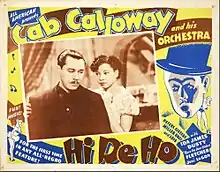Hi-De-Ho (1947 film)
Hi De Ho (also known as Hi-De-Ho) is a 1947 American musical race film [1][2][3] directed by Josh Binney. Distributed by All American Entertainment, the film stars an all African American cast, led by Cab Calloway. It first showed at the Squire Theatre in New York.[3]
| Hi-De-Ho | |
|---|---|
 Lobby card | |
| Directed by | Josh Binney |
| Produced by | E. M. Glucksman |
| Written by | Hal Seeger |
| Starring | Cab Calloway Ida James Jeni Le Gon |
| Music by | Cab Calloway and his orchestra |
| Cinematography | Don Malkames |
| Edited by | Louis Hess |
| Distributed by | All American Entertainment |
Release date |
|
Running time | 72 minutes |
| Country | United States |
| Language | English |
He performs a number of songs in the film, including the a capella version of "Minnie Was A Hepcat" and "St. James Infirmary," "At Dawn Time," "Hey Now," and "The Hi De Ho Man" with his orchestra,[1] and also provides incidental music for the other performers. He sings a duet with Elton Hill on "I Got a Gal Named Nellie."[3] There was a guest appearance by Dusty Fletcher who performed his record hit "Open the Door, Richard!".[2] The Peters Sisters sang "Little Old Lady from Baltimore" and "A Rainy Sunday."[2]
Musicians in the orchestra include: Jonah Jones, trombonist Quentin Jackson, tenor saxophonist Sam "The Man" Taylor, pianist Dave Rivera, Milt Hinton and drummer Panama Francis.[1] The film also features tap dancers Miller Brothers and Lois doing their routine on built up blocks and stands.[3]
Plot
Cab Calloway, an up and coming jazz musician is putting together a band, he was looking forward to making it big as the bandleader. His girlfriend Minnie, was upset that Cab has retained the services of a female band manager to help him promote his band and get his first big break. His band manager gets him a chance to audition his jazz octet before the local owner of the new club, which he then signs the big band for its opening. Minnie becomes suspicious and jealous that Nettie, as Cab's new female band manager, is doing good things for Cab and is winning points with him.[2][3]
When Cab auditions with his octet, the new club owner is impressed, but he said that he needs his band for his club opening to become more successful. He gets the job when he says that he can easily recruit more band members, and he opens for the new club for its opening at the end of the week.[2][3]
When he and his band make their success, Minnie gets intensely jealous and goes to a local "fix-it" man Boss Mason, who uses gun man Mo the Mouse as his 'assistant'. Minnie starts to play both sides of the fence in wanting to be his girlfriend, while also trying to keep Cab in place so that his relations with Nettie have "no chance to blossom". When Boss Mason gets too close to Cab, Cab must defend himself against Mo the Mouse before the bullets fly.[2][3]
Cast
- Cab Calloway as himself
- Cab Calloway Orchestra with Elton Hill as themselves
- Ida James as Nettie
- Jeni Le Gon as Minnie
- William Campbell as Sparks
- Virginia Girvin as Sparks' Girl Friend
- George Wiltshire as Boss Mason
- James Dunmore as Mo the Mouse
- Augustus Smith as Preacher
- Edgar Martin as Jive Club Owner
- Leonard Rogers as Ralph
- David Bethea as Brass Hat Club Owner
- Shepard Roberts as Police Sergeant
- Frederick Johnson as Headwaiter
- Dusty Fletcher as himself
- The Peters Sisters (Entertainer)
- The Miller Brothers & Lois (Entertainers)
Review
Variety noted, "Calloway fans will find Hi De Ho right up their alley .... Story is just one of those things ... (it) is primarily an excuse for spotlighting some okay vaude acts on celluloid but the audience it's aimed at will overlook the technical deficiencies.[3]" Calloway was natural enough and Ida James and Jeni Le Gon did the best they could with the slim script.[3] The movie would be shown in the more than 500 African-American theaters in the US.[3]
Further reading
- Sampson, Henry T. "Blacks in black and white : a source book on Black films, 1995, Metuchen, N.J. : Scarecrow Press, Isbn 0810826054". archive.org. Retrieved January 15, 2021.
External links
| Wikimedia Commons has media related to Hi-De-Ho (1947 film). |
- Hi-De-Ho at IMDb
- Hi-De-Ho is available for free download at the Internet Archive
References
- Yanow, Scott. "Jazz on film : the complete story of the musicians & music onscreen, 2004, p.168-169 San Francisco, CA : Backbeat Books". archive.org. Retrieved January 14, 2021.
- Pitts, Michael. "Astor Pictures: A Filmography and History of the Reissue King, 1933-1965, p.89 Jefferson, NC: McFarland & Company, Inc". google.com/books. Retrieved January 15, 2021.
- "Variety, May 14, 1947, p. 15". archive.org. Retrieved January 15, 2021.